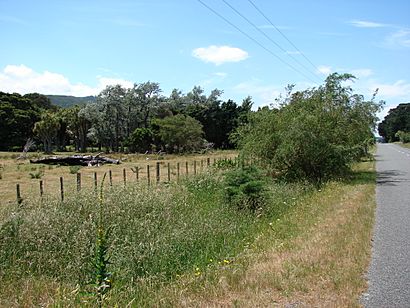Pigeon Bush railway station facts for kids
Pigeon Bush railway station was a small train station in a rural area called Pigeon Bush. This area is in the South Wairarapa district of New Zealand's North Island. The station was about 6 kilometers (4 miles) south-west of Featherston.
Pigeon Bush station was located on the Wairarapa Line. It was between the Featherston and Cross Creek stations. The station was no longer needed after the Rimutaka Tunnel opened, which created a new, easier route for trains.
Contents
The History of Pigeon Bush Station
Building the Station
When the Rimutaka Incline was being built, some land was set aside for a new train station. This land was near a stream called Lucena's Creek, which is now known as Owhanga Stream. The station was first planned to be called Lucena's.
However, by the time the station opened in 1878, its name had been changed to Pigeon Bush. It had a platform for passengers and a small shelter. There was also a special area for loading goods, especially sheep. The station also had a loop siding and a crossing loop. These were extra tracks that allowed trains to pass each other or wait.
Daily Life at the Station
The main type of goods transported from Pigeon Bush station was sheep. But the station's most important job was to be a place where trains could cross paths.
Sometimes, special H class Fell locomotives were used here. These powerful engines helped push trains up the steep Rimutaka Incline from Pigeon Bush to Cross Creek. This practice continued until about 1943. By 1922, the station had a full signalling system to control train movements safely.
Dealing with Strong Winds
The area around Pigeon Bush was known for very strong winds. On January 19, 1888, a train leaving Pigeon Bush for Featherston was blown off its tracks by a powerful gust of wind. Luckily, no one was seriously hurt.
After this incident, fences and rows of willow trees were planted along the railway line. These were meant to act as windbreaks and protect trains. However, on October 8, 1936, a Wairarapa railcar named Mamari was overturned by a strong wind just north of the windbreak. No one died, but some passengers needed hospital care. This event led to the windbreak fence being made even longer.
The Station Closes
Pigeon Bush station closed on October 30, 1955. This happened because the old railway line over the Rimutaka Ranges was being shut down. A new, easier route through the Rimutaka Deviation was about to open. Once the old line and station buildings were removed, the road in the area went back to its original path.
Pigeon Bush Today
Today, it's hard to find any clear signs that a train station once stood at Pigeon Bush. The old road that went around the station area can still be seen. It now leads to a nearby farm. The railway house that was on the site, which lasted longer than the station, has also been removed. However, you can still see the old piles from the rail bridge that used to cross the Owhango Stream, just south of where the station was.
The Future of the Line
The Rimutaka Incline Railway Heritage Trust is a group that wants to rebuild the original railway line over the Rimutaka Ranges. They plan to start from Maymorn. So far, they haven't made any definite plans about rebuilding the section of the line between Cross Creek and Featherston.
Gallery






